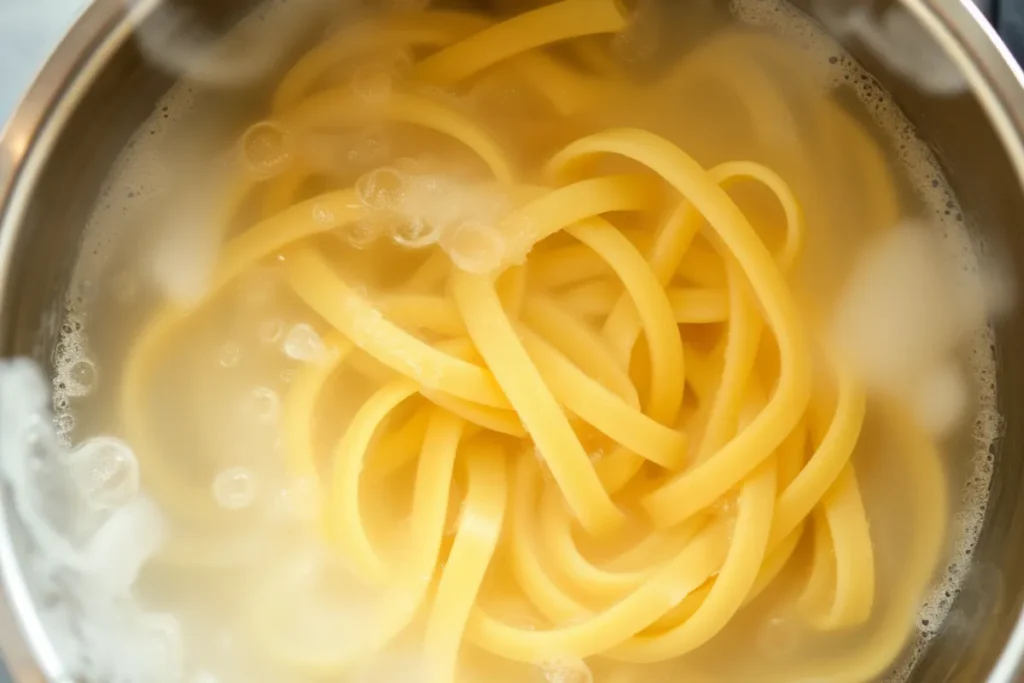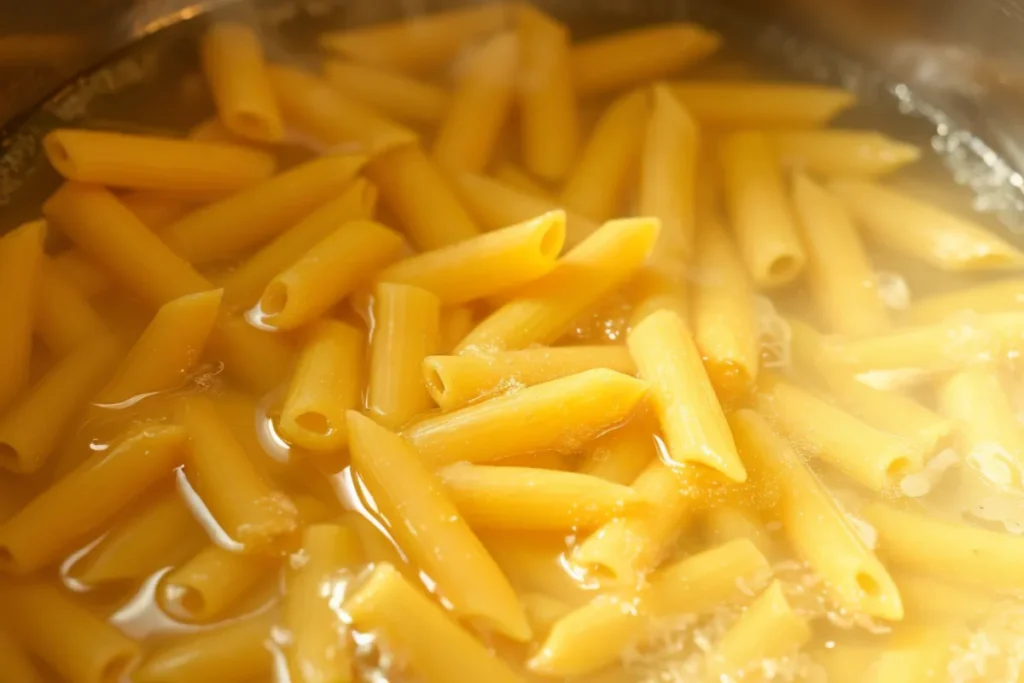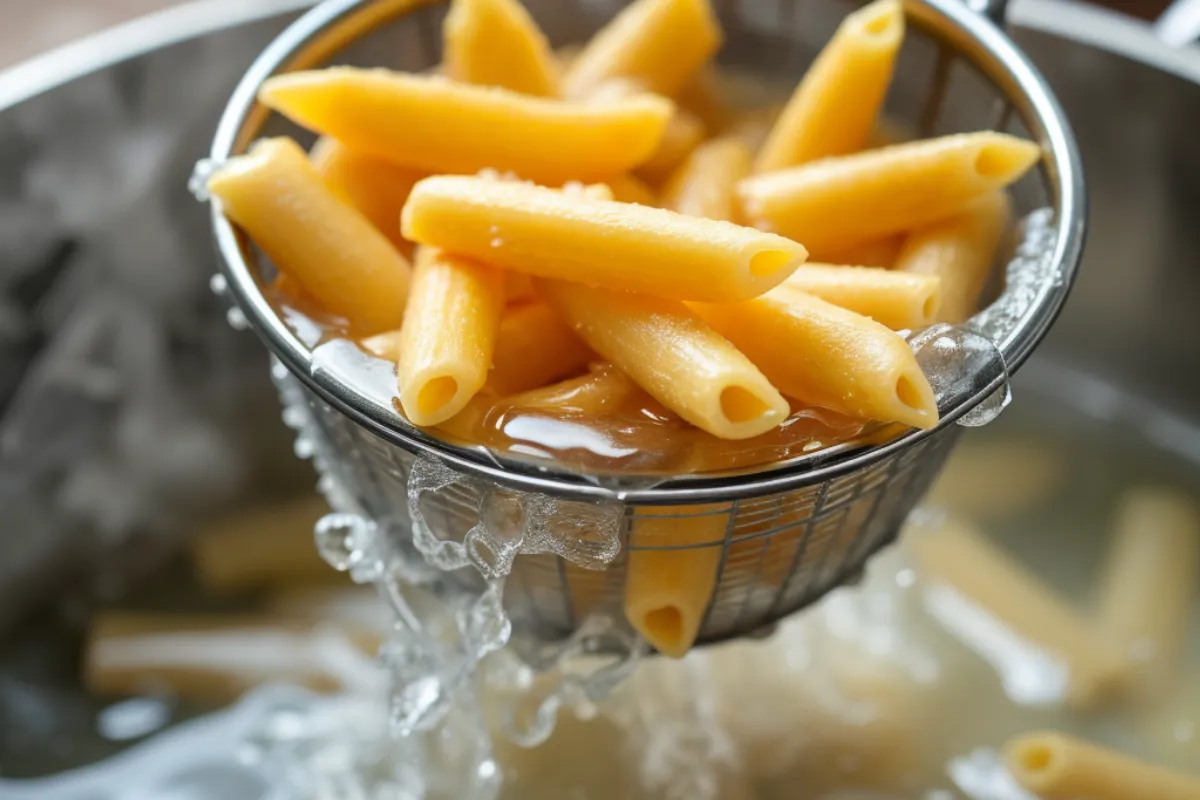Introduction to Boiling Pasta Al Dente
Learning how to boil pasta al dente is an essential skill for any home cook who wants to elevate their pasta dishes. The term al dente refers to pasta that’s cooked just right—firm to the bite but not hard or undercooked. It’s the balance between soft and chewy, making it the ideal texture for most pasta dishes.
Achieving this might seem tricky, but with the right technique, you can master it every time. Whether you’re making spaghetti, penne, or fettuccine, following the right steps ensures that you’ll never end up with mushy or too-firm pasta again. Let’s dive into how you can boil pasta al dente and transform your cooking game.
What Does Al Dente Mean?
The phrase al dente comes from Italian, meaning “to the tooth.” But what exactly does that imply for your pasta? Essentially, it refers to the texture of the pasta being firm but tender—not too soft and definitely not overcooked. The goal is for the pasta to have a slight bite when you test it.
Why does this matter? Al dente pasta holds its shape better and absorbs sauces more effectively. When pasta is overcooked, it becomes gummy and loses its ability to pair well with sauces, impacting the overall flavor and presentation of your dish.
Here’s how you can tell if pasta is al dente:
- It should be slightly firm in the center.
- When you bite into it, there should be a slight resistance, but it shouldn’t be crunchy.
The Science Behind Pasta and Cooking Time
Ever wonder why you need to follow a specific cooking time for pasta? It all comes down to the starch and gluten within the pasta. When pasta is cooked, starches in the dough expand and absorb water, softening the pasta. At the same time, gluten proteins give pasta its structure and texture.
Timing plays a crucial role in how these elements interact. Boiling pasta for too long breaks down the starches too much, resulting in mushy noodles. On the flip side, not boiling it long enough leaves it undercooked and too firm. Knowing when to stop boiling is the key to reaching that perfect al dente texture.
Choosing the Right Pasta for Al Dente Cooking

Not all pastas are created equal. Each pasta shape and thickness has a different cooking time, which influences when it reaches its al dente state. Understanding how to boil pasta al dente means knowing how different pasta shapes cook. For example, thin pasta like angel hair cooks much faster than thicker shapes like rigatoni or fusilli. For a dish like Marry Me Chicken Pasta, using a pasta like penne ensures that the sauce clings well, maintaining the al dente texture.
To achieve al dente with your chosen pasta, always check the cooking time suggested on the packaging. But don’t stop there—many packages give times for fully cooked pasta, not necessarily al dente. To be safe, start testing your pasta a minute or two before the recommended time.
Some useful tips:
- Thin pasta: Typically takes 4-7 minutes for al dente.
- Medium pasta (like spaghetti): Cooks in 8-10 minutes.
- Thicker pasta: Can take 10-12 minutes or more.
For more details on how various types of pasta should be cooked, check out this guide to fixing overcooked pasta to help adjust your cooking if needed.
Ideal Water-to-Pasta Ratio
Believe it or not, the amount of water you use when boiling pasta is just as important as the cooking time. Using too little water can cause the pasta to stick together and cook unevenly, while too much water can dilute the starchy goodness that pasta releases during boiling.
Here’s the golden rule: 4-6 quarts of water for every pound of pasta. This ratio helps ensure that the pasta has enough room to move around freely and cook evenly. Not only does it prevent the pasta from sticking, but it also makes sure the heat is distributed equally.
To measure it properly:
- For smaller servings, use 3 quarts of water for 1/2 pound of pasta.
- For larger batches, stick with the 4-6 quarts per pound rule.
Water Temperature and the Role of Salt
Water temperature plays a crucial role in boiling pasta properly. Always wait until your water reaches a rolling boil before adding pasta. This ensures that the pasta cooks evenly from the start. Adding pasta to cold or lukewarm water will lead to inconsistent cooking.
Equally important is the salt. Many people skip salting their water, but it’s essential for enhancing the flavor of the pasta itself. As the pasta cooks, it absorbs the salted water, seasoning it from the inside. This way, even if you don’t have a heavily flavored sauce, your pasta will still taste good.
A general guideline is to add 1-2 tablespoons of salt per gallon of water. Don’t worry—the pasta won’t absorb all that salt, but it’ll add just the right amount of seasoning.
You can read more about the importance of salt in pasta water to learn how it impacts flavor.
Step-by-Step Guide to Boiling Pasta Al Dente
Now that you’ve prepared your water and selected your pasta, it’s time to start cooking. The boiling process is straightforward, but each step is crucial for achieving perfect al dente pasta.
Here’s a step-by-step guide on how to boil pasta al dente:
- Bring Water to a Rolling Boil: Wait until your water is fully boiling—bubbles should be constant and large. This is essential for even cooking.
- Add Salt: Don’t forget to salt the water! As mentioned, you should add about 1-2 tablespoons of salt per gallon of water. This step enhances the flavor of the pasta from within.
- Add Pasta: Once the water is boiling, add the pasta. Stir immediately to prevent it from sticking together.
- Boil and Stir Occasionally: Let the pasta boil uncovered. Stir occasionally to ensure even cooking and avoid clumping.
- Check for Al Dente: Start testing your pasta about 2 minutes before the package’s recommended cooking time. Bite into a piece to check if it’s firm yet tender. This is the hallmark of al dente pasta.
- Strain or Remove the Pasta: Once the pasta reaches the al dente texture, strain it using a colander. You can reserve some pasta water if you plan on using it for the sauce.
By following these steps carefully, you’ll guarantee perfectly cooked pasta every time.
The Cold Water Myth: Should You Rinse Pasta?
Many people have heard that rinsing pasta after boiling is necessary, but this is one of the most common pasta myths. In most cases, you should avoid rinsing your pasta. Here’s why:
- Rinsing removes starch: During cooking, pasta releases starch, which helps sauces cling to it. Rinsing pasta washes away that valuable starch, making your sauces less effective.
- Rinsing cools the pasta: If you rinse the pasta, you’ll also stop it from continuing to cook after you drain it, which is essential if you want your pasta to remain hot and ready to serve with your sauce.
When should you rinse pasta? The only exceptions are for cold pasta salads or dishes where you don’t want the pasta to be sticky. For regular pasta dishes, let that starch work its magic.
Testing Pasta for Al Dente Perfection
Knowing when your pasta is perfectly al dente takes some practice, but there are a few foolproof methods to help you out. Most pasta packages provide a cooking time range, but to ensure your pasta is al dente, you should always check it yourself.
Here’s how to test your pasta:
- Bite Test: The easiest and most reliable method. Simply take a piece of pasta out of the pot, cool it slightly, and bite into it. You’re looking for a firm bite with a slight resistance, but no crunch.
- Cut Test: Take a piece of pasta and cut it in half. If you see a thin white line or dot in the middle, the pasta is likely al dente.
- Taste Test: In the end, taste is the best indicator. If it feels too firm or hard to chew, it needs more time. If it’s too soft, it’s overcooked.
Testing your pasta ensures you’ll hit that sweet spot where the pasta is neither undercooked nor mushy. Knowing how to boil pasta al dente requires regular testing for firmness.
What to Do After Boiling: Draining and Resting

Once your pasta reaches the perfect al dente texture, it’s time to drain it. While this sounds simple, there are a few tips to keep in mind to maintain your pasta’s texture.
- Use a Colander or Slotted Spoon: Drain your pasta in a colander to remove all the water. Alternatively, for certain pasta shapes, a slotted spoon can be useful if you’re cooking pasta in small batches.
- Reserve Some Pasta Water: Before draining, scoop out a cup of pasta water. This starchy water can help thicken your sauce and improve its ability to cling to the pasta.
- Avoid Letting Pasta Rest Too Long: Pasta can continue to cook slightly after you’ve drained it. To prevent overcooking, toss the pasta with your sauce as soon as possible. If you let the pasta sit, it can become mushy and lose its al dente bite.
Pairing Pasta with Sauces for Maximum Al Dente Enjoyment
Pasta doesn’t just stop at cooking—how you pair it with sauces can make or break your dish. The sauce you choose plays a big role in how well your pasta holds onto its al dente texture. Creamy sauces, like in this Marry Me Chicken Pasta, complement the firm bite of al dente pasta perfectly.
Some pairings that work best:
- Light Sauces: Olive oil, pesto, and simple tomato sauces work well with al dente pasta because they cling to the pasta’s surface, enhancing the firm texture.
- Creamy Sauces: While delicious, heavy cream sauces can sometimes overwhelm the pasta’s al dente bite. For these, you may want to cook your pasta slightly less than al dente to ensure it doesn’t soften too much when mixed with the sauce.
The starch on the pasta from boiling (which you preserved by not rinsing) helps your sauce stick better, creating a balanced and flavorful dish.
Fixing Overcooked or Undercooked Pasta
Even experienced cooks sometimes misjudge pasta cooking times. If you find that your pasta is overcooked, don’t panic—there are ways to salvage it.
For Overcooked Pasta:
- Quickly drain the pasta and rinse it with cold water to stop further cooking.
- Sauté the pasta in olive oil or butter for a couple of minutes to give it a slightly firmer texture.
For Undercooked Pasta:
- Simply return it to the pot of boiling water and cook for an additional 1-2 minutes.
- You can also finish cooking the pasta in the sauce, allowing it to absorb more flavor while softening up.
Common Mistakes to Avoid When Boiling Pasta
Even with the right preparation and steps, a few common mistakes can ruin your efforts to achieve al dente pasta. Here are some pitfalls to watch out for:
- Not Stirring Enough: If you don’t stir the pasta right after adding it to the water and occasionally while it’s cooking, it can stick together and cook unevenly.
- Overcrowding the Pot: Cooking too much pasta in too little water will make it clump together and cook poorly. Always follow the water-to-pasta ratio guidelines.
- Forgetting to Salt the Water: Unsalted pasta can taste bland, even if you have the best sauce. Make sure you always salt your water sufficiently before boiling.
FAQs
How long do you boil pasta to get it al dente?
Typically, pasta reaches its al dente texture between 8-10 minutes, depending on its shape and thickness. Always start testing 2 minutes before the suggested cooking time on the package.
Can you make gluten-free pasta al dente?
Yes, you can make gluten-free pasta al dente, but the cooking time may vary depending on the brand and ingredients. Gluten-free pasta often requires closer monitoring since it can become mushy faster than traditional pasta.
What happens if pasta isn’t cooked al dente?
If pasta isn’t cooked al dente, it can be too soft, which may cause it to break down in the sauce or lose its shape. This affects both the texture and the overall flavor of the dish.
How do you know when pasta is al dente?
The best way to tell if pasta is al dente is to bite into it. It should feel firm but not hard, with a slight resistance in the center when chewed.
Is it okay to reheat pasta and maintain al dente texture?
Yes, you can reheat pasta and still maintain its al dente texture. The key is to avoid overcooking it when reheating. You can reheat it by sautéing it in a bit of olive oil or adding it directly into a sauce.

